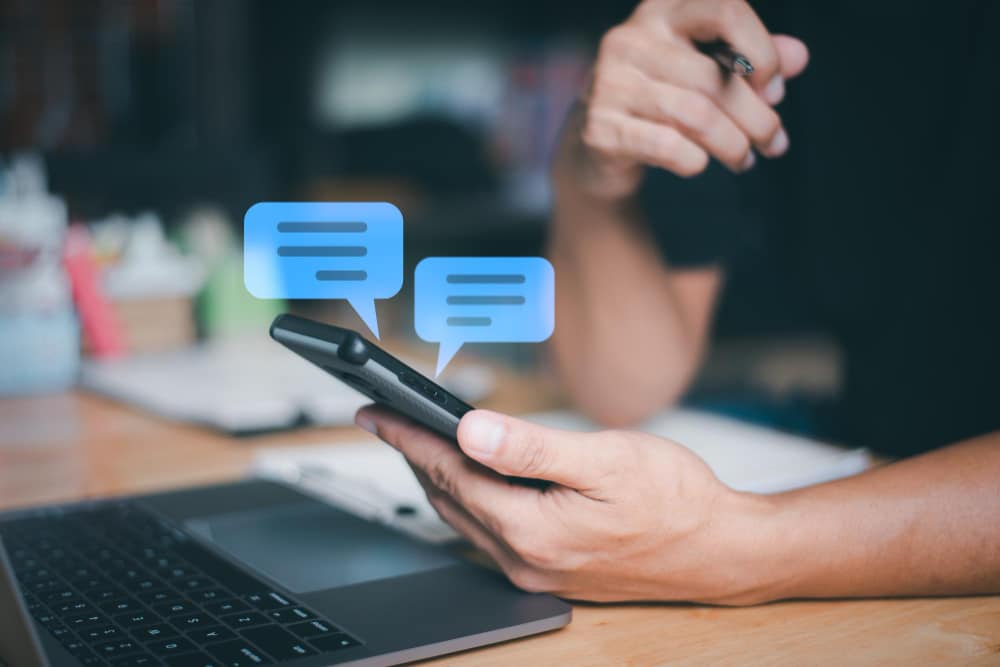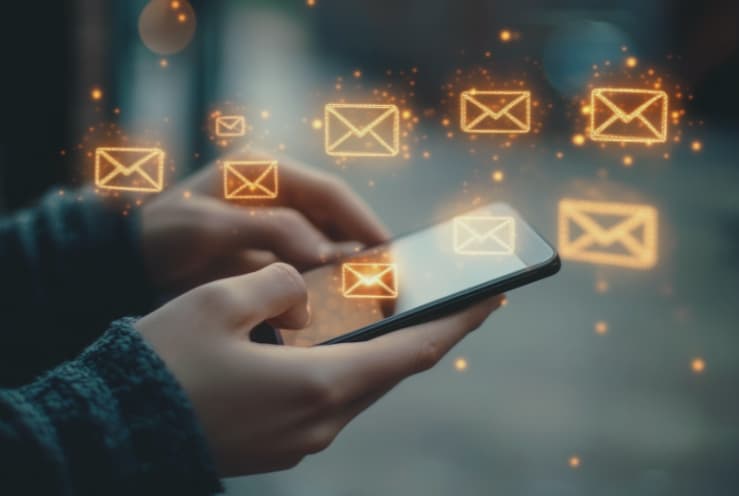
How SMS Supports Promotion in Marketing Campaigns
Even with a well-developed product and strong value proposition, your sales messages to customers can fail if it doesn’t reach them when and where they are most likely to respond.
Traditional marketing often competes for attention in increasingly saturated spaces. As a result, your campaigns may receive less engagement than expected despite thoughtful planning.
Many businesses are adopting more direct and timely communication methods to bridge this gap.
Text message advertising has become the best solution because of its immediacy and visibility. Most customers check their phones multiple times a day, and text messages are often opened within minutes.
In this article, we’ll explain how SMS supports promotion in marketing campaigns by improving timing, increasing visibility, and helping you build faster customer responses.
What Is Promotion in Marketing?
Promotion in marketing refers to the process of communicating with your audience to raise awareness, generate interest, and encourage action toward your product or service.
This part of marketing focuses on how you engage with your target market. It covers everything from advertising and social media marketing to direct outreach and sales campaigns.
Many businesses depend on a combination of organic content and paid advertising to grow their reach and engage with the right audience.
How Promotion Differs From Overall Marketing
Marketing is the larger plan that shapes your brand, your message, and your offer. It includes product development, pricing strategy, market research, customer experience, and distribution channels.
For example, if you own a skincare brand, your product line, packaging, pricing, and website are all part of your marketing.
Promotion attracts customers to your offer. It initiates conversations and keeps your brand in customers’ minds. Well-crafted campaigns can help retain customers who might otherwise forget about your product or service.
It is also one of the four pillars of the traditional marketing mix, alongside product, price, and place. While those three focus on what you’re offering, how much it costs, and where it’s sold, promotion is the part that helps people understand why they should care.
When you’re launching something new or trying to grow an existing brand, promotion helps you increase brand awareness, interest, and demand. This might include time-limited discounts or giveaways, tactics often seen in sales promotion strategies designed to encourage action.
Types of Promotional Marketing
There are various promotional marketing strategies to promote a product or service, each with a specific purpose.
Below are the main types of promotional marketing, along with their functions and the situations where you might use them.
Advertising
Advertising is one of the most widely used forms of promotion marketing.
The purpose of advertising is to inform and persuade. You use it to shape how people perceive your brand and guide them toward making a decision.
Organic content or public relations efforts that depend on third-party platforms or earned media. However, advertising guarantees placement and scalable messaging across regions or demographics.
Traditional vs. Digital Advertising
Advertising can be categorized into two main types: traditional and digital marketing.
Traditional advertising includes various formats, including television, radio, and print media, such as newspapers. They reach a broad audience and are helpful for repeated brand exposure. However, they also come with higher costs and limited targeting.
Digital advertising, on the other hand, allows you to use targeted advertising based on user behavior, demographics, and interests. Platforms such as Google, Facebook, Instagram, YouTube, and LinkedIn offer ad placements in search results, feeds, videos, or web pages.
Sales Promotion
Sales promotion is a short-term tactic used to encourage people to take action quickly. You can use it to boost sales, introduce new customers, or re-engage customers who haven’t purchased in a while.
They also create opportunities for you to test new offers or gather feedback without committing to a long-term strategy.
There are several formats to choose from, depending on your target audience and business type.
- Discounts are one of the most direct methods for achieving this goal. Providing either a percentage discount or a flat dollar amount encourages initial purchases.
- Buy-one-get-one (BOGO) promotions encourage larger purchases. This is common in retail and can help move seasonal promotions faster.
- Loyalty programs reward loyal customers for repeated purchases. When buyers collect points or credits with each purchase, they’re more likely to return.
- Referral bonuses use your customers’ networks by rewarding both referrers and new buyers, turning word of mouth into a growth channel.
- Flash sales and limited-time offers create a sense of urgency. These promotions are brief, with a precise end date. They can be promoted through SMS, email, and banners on your website.
To maximize the effectiveness of your promotional marketing campaign, it’s important to choose the right channel. SMS can be a powerful small business tool to get your offers seen quickly.
Since people check their phones frequently, sending a sales text message helps you capture attention.
Textellent allows you to schedule messages, create audience segments, and track responses. You can use it to send flash sale alerts, coupon codes, and reminders without overwhelming your audience.
Public Relations
Public relations (PR) is a promotional method that focuses on how the public perceives your company’s reputation.
While advertising and sales promotions are built on paid messages, PR centers around earned attention. It involves building relationships with media outlets, industry voices, customers, and the broader community.
PR works best when it complements your broader strategy. If you’re running a product launch campaign, you can support it with a press release and pitch the story to relevant blogs or podcasts.
It also supports long-term trust. A good article, a featured interview, or a well-handled crisis can leave a lasting impression.
Personal Selling
Personal selling is a promotional approach based on one-on-one communication with a potential customer to build customer relationships and close a sale.
Compared to mass advertising or email campaigns, it focuses on individual conversations that help guide someone through the decision-making process.
If you operate in B2B markets or if your service requires contracts or demonstrations, personal selling plays a major role in your promotion strategy. Even in B2C markets, businesses that sell through retail reps, field agents, or service consultations use personal selling to guide customer choices.
Direct Marketing
Direct marketing is a promotional method that allows you to connect with customers or prospects in a personal, one-to-one format. You can deliver a message straight to the person you’re targeting, often with an explicit action you want them to take.
The power of direct marketing lies in its focus. Rather than targeting a broad audience, you concentrate on specific individuals or groups. This method helps keep your messaging relevant and makes it easier to track results.
You can also test different offers, messages, and delivery times to find the most effective combination. Because you control the message and the channel, your communication stays consistent with your brand’s tone and style.
Direct Marketing Channels You Can Use
There are several ways to use direct marketing in your business. The best channel depends on your target audience and the nature of your product or service.
- Email marketing allows you to send newsletters, product updates, and promotional content to your subscribers’ inboxes.
- Direct mail involves sending physical items, such as free samples, catalogs, or brochures. While used less often today, it can still be effective for specific industries or local campaigns.
- Phone calls offer a more personal way to follow up or close a sale, though they are time-intensive and not always scalable.
- SMS marketing is one of the most immediate and personal options. It places your message right on a customer’s phone screen, where it’s likely to be seen within minutes.
Among these, SMS stands out because of its high open rates. Ecommerce SMS marketing studies show that most people (90%) read a text within minutes. If you’re running a successful sales promotion, sending a brief message can produce quick results.
Textellent is an excellent choice if you want to use SMS in your business. If you’re launching a sale or sending automatic text reminders, Textellent makes it easy to keep in touch without spamming.
Sign up for a free trial or book a demo today!
Digital Promotions
Digital promotions are marketing efforts that use online channels to capture attention, drive traffic, and increase online sales.
These promotions are a key part of modern business strategy because they target people where they already spend time.
You can run digital promotions across several online channels. Each one has its strengths and purpose, depending on what you’re trying to achieve.
- Search engines promote your content through search engine optimization (SEO) and paid listings. Google Ads is the most common platform for this. You can show your offer when someone searches for terms related to your product or service.
- Social media platforms like Facebook, Instagram, LinkedIn, and TikTok offer paid and organic promotion options. You can create posts, run contests, or launch ad campaigns to reach customers and new audiences.
- Websites and blogs help you promote offers through banners, pop-ups, or featured product sections. If you run a blog, including a promotional call to action (CTA) within a post can increase your response rate.
- Email and SMS also play a crucial role in this process. When combined with digital ads or website content, these channels allow you to continue the conversation in a personal way.
With a tool like Textellent, you can build SMS campaigns that link to a landing page, include a coupon code, or remind people about an expiring deal. The platform also allows you to segment your list, which allows you to send the right offer to the right person.
How to Create a Successful Promotion Strategy
A good promotional strategy involves careful planning, understanding your audience, and selecting the optimal combination of channels and messages.
Here are the key elements that can help your business craft and manage a successful promotion strategy.
1. Start With a Reason for the Promotion
Without purpose, even the most well-designed campaign can feel disconnected from you and your audience. Before planning anything, ask yourself a key question: Why are you offering this promotion now?
First, review your internal data and data collection activities. You might notice that a product category is underperforming. Maybe engagement is down among existing customers, or you are about to introduce a new product or service.
All of these are valid triggers that give context to your offer.
Promotions can also be tied to the calendar. Seasonal changes, holiday shopping periods, annual sales events, or back-to-school cycles provide you with timely opportunities to engage your audience.
Once you have a clear reason and message, timing becomes essential. This is where SMS marketing proves its value. It allows you to send the promotion when it is most relevant, not just when you happen to schedule an email or post on social media.
Using automated texting software, you can send your promotion to a targeted group with a short, focused message. It’s easier to match the offer to the people who are most likely to take action when you’re looking to improve customer retention.
2. Choose One Objective and Focus on It
Trying to increase sales, grow your SMS subscriber list, promote a new product, or improve customer engagement, all in a single campaign, often leads to a message that lacks direction.
Before creating your marketing and promotion material, you need to identify the outcome you are aiming for. Some clear objectives might be:
- Drive sales for a specific product
- Get 500 new SMS subscribers before your next first purchase offer
- Encourage sign-ups for an upcoming event or promotional period
When the goal is well-defined, every part of your campaign can work toward it. This also makes it easier to measure success after the campaign ends.
However, keep in mind that success metrics should be reviewed with caution. If not properly tracked, specific campaigns may generate misleading sales data. It could lead to decisions based on inaccurate information rather than actual performance.
3. Layer Your Channels for Consistent Messaging
People engage with content in different ways and at different times. You need to use multiple channels that support the same message.
When you layer channels, you create consistent touchpoints across various formats, including email, SMS, social media, and your website. Each one works together to reinforce your offer and create demand.
Here is an example of how to layer a promotion:
- Announce the offer through email in the morning
- Share a supporting post on social media that afternoon
- Send an SMS reminder a few hours before the offer expires
- Add a banner to your website for the duration of the promotion
Each message refers back to the same offer, but the delivery is spread out and tailored to the platform. It keeps your audience updated without overloading them.
SMS is one of the most effective tools when the timing of your offer matters. Since people tend to scan texts immediately, it makes texting perfect for reminders, final calls, and alerts.
When SMS is used alongside your email and social content, it gives your promotion greater visibility and helps build long-term customer loyalty.
4. Time Your Promotions Strategically
Good timing increases your chances of getting a response. Therefore, you need to carefully consider when your promotion starts, how long it will run, and how frequently your audience will hear from you.
Understanding your customer’s habits is the first step. If your audience is primarily working professionals, early morning or evening campaigns may be more effective. If you serve parents, the timing around school hours might matter more.
Channels like email and social media may experience delays or lower visibility. SMS marketing allows you to reach people instantly when you need to highlight deadlines or time-limited deals.
With Textellent, you can schedule messages at key times. This type of push strategy can double your engagement rate when combined with other channels.
If you want to strengthen campaign value further, consider adding free products for first-time buyers or including limited-time free items as part of your call to action. These extras can help your audience feel appreciated and increase response rates without compromising your message.
5. Keep the Offer Simple and Valuable
A good offer should be easy to understand and worth your customer’s attention. The simpler your promotion is, the better your results will be.
The first thing your customer should notice is what the promotion includes. You need to stick to a single message and avoid vague terms.
For example, “Get 20 percent off your next order” is more effective than “Special savings now available.” It tells people what they’re getting and when.
If you are running the promotional messages through text, keep the message brief yet direct. You can include a link if needed and be upfront about any restrictions.
6. Plan for the Follow-Up in Advance
Running a promotion does not end when the offer goes live. You should plan the follow-up before the campaign even begins to maximize your effort.
A follow-up should not just repeat the same message but instead move the conversation forward. Think of it as a second chance to guide your customer toward a decision.
Examples of follow-up strategies include:
- Sending a second SMS to users who opened the first but did not click
- Offering a smaller incentive the day after the main offer ends
- Asking for feedback through SMS review requests from people who used the promotion
SMS marketing software allows you to schedule follow-up messages based on the customer’s actions or inaction. You can also automate thank-you texts that make customers feel appreciated and increase their likelihood of returning.
Recommended Reading:
40 Customer Appreciation Ideas to Win Trust and Retain Clients
Make Your Marketing More Direct—Start Getting Results With Textellent!
Looking for a better way to run your promotions and reach your customers?
Traditional channels can be easily overlooked. That’s why more businesses are using Textellent to send targeted promotions through SMS.
Textellent allows you to schedule messages at important campaign milestones. You can organize contacts into groups, send customized offers, and follow up according to customer responses.
It also supports a hybrid strategy, combining the immediacy of SMS with your existing marketing channels to strengthen your campaign reach.
If you want your promotions to generate more clicks, sales, and repeat business, SMS should be a central part of your marketing strategy. Textellent makes it easy to deliver the right message at the right time while driving measurable brand growth.
Sign up for a free trial or request a demo consultation and turn every promotion into something your customers act on!
FAQs About Promotion in Marketing
What is promotion in a market?
Promotion in a market refers to the methods a business uses to attract attention and encourage customers to buy a product or service. It includes activities such as advertising, offering discounts, making public announcements, and conducting direct outreach.
The goal is to inform people about what you offer, why it matters, and how they can access it. Promotion helps introduce new or re-engage past customers, connecting your message with those who need to hear it and supporting long-term retention.
These efforts are all part of effective marketing communications that aim to build trust and increase product awareness over time.
What is marketing promotion with an example?
Marketing promotion refers to the tools and tactics used to communicate an offer and drive engagement or sales.
For example, if you launch a new product, send an email with a discount code to your subscribers, and follow up with a reminder using SMS through Textellent, that is a promotion.
This approach combines different strategies into a single effort. It can also help stimulate consumer demand and improve your average order value. It’s effective when paired with attractive incentives, such as free shipping promotions or complimentary items for early buyers.
What does promoted mean in marketing?
When something is promoted in marketing, it means it is actively shown to a target audience. This can include paid ads, featured content, announcements, or limited-time deals.
For example, a “promoted post” on social media has been paid for to reach a larger audience. In broader terms, when you promote a product or service, you are using content marketing, timing, and placement to reach potential buyers.
The goal is to drive interest while also aligning with your business goals, strengthening brand loyalty, and rewarding customers for engaging with your brand.





